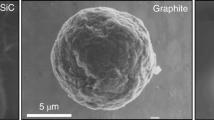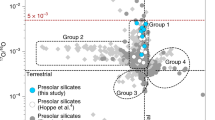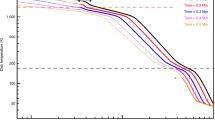Abstract
Grains of dust that pre-date the Sun provide insights into their formation around other stars and into the early evolution of the Solar System1,2,3,4. Nanodiamonds recovered from meteorites, which originate in asteroids, have been thought to be the most abundant type of presolar grain3,4. If that is true, then nanodiamonds should be at least as abundant in comets, because they are thought to have formed further out in the early Solar System than the asteroid parent bodies, and because they should be more pristine5,6,7. Here we report that nanodiamonds are absent or very depleted in fragile, carbon-rich interplanetary dust particles, some of which enter the atmosphere at speeds within the range of cometary meteors8,9. One interpretation of the results is that some (perhaps most) nanodiamonds formed within the inner Solar System and are not presolar at all, consistent with the recent detection of nanodiamonds within the accretion discs of other young stars10. An alternative explanation is that all meteoritic nanodiamonds are indeed presolar, but that their abundance decreases with heliocentric distance, in which case our understanding of large-scale transport and circulation within the early Solar System is incomplete11.
This is a preview of subscription content, access via your institution
Access options
Subscribe to this journal
Receive 51 print issues and online access
$199.00 per year
only $3.90 per issue
Buy this article
- Purchase on Springer Link
- Instant access to full article PDF
Prices may be subject to local taxes which are calculated during checkout



Similar content being viewed by others
References
Hoppe, P. & Zinner, E. Presolar dust grains from meteorites and their stellar sources. J. Geophys. Res. 510, 10371–10385 (2000)
Daulton, T. L., Eisenhour, D. D., Bernatowicz, T. J., Lewis, R. S. & Buseck, P. R. Genesis of presolar diamonds: comparative high-resolution transmission electron microscopy study of meteoritic and terrestrial nano-diamonds. Geochim. Cosmochim. Acta 60, 4853–4872 (1996)
Anders, E. & Zinner, E. Interstellar grains in primitive meteorites: diamond, silicon carbide, and graphite. Meteoritics 28, 490–514 (1993)
Bernatowicz, T. J. & Walker, R. M. Ancient stardust in the laboratory. Phys. Today 50, 26–32 (1997)
Farinella, P., Gonzi, R. & Froeschle, C. The injection of asteroid fragments into resonances. Icarus 101, 174–187 (1993)
Greenberg, J. M. in Comets (ed. Wilkening, L. L.) 131–162 (Univ. Arizona Press, Tucson, 1982)
Huss, G. in Astrophysical Implications of the Laboratory Study of Presolar Materials (eds Bernatowicz, T. & Zinner, E.) 721–748 (AIP Press, New York, 1997)
Bradley, J. P. & Brownlee, D. E. Cometary particles: thin-sectioning and electron-beam analysis. Science 231, 1542–1544 (1984)
Brownlee, D. E. et al. Identification of individual cometary IDPs by thermally stepped He release. Lunar Planet Sci. XXVI, 183–184 (1995)
Van Kerckhoven, C., Tielens, A. G. G. M. & Waelkens, C. Nanodiamonds around HD 97048 and Elias 1. Astron. Astrophys. 384, 568–584 (2002)
Hill, H. G. M., Grady, C. A., Nuth, J. A., Hallenbeck, S. L. & Sitko, M. L. Constraints on nebular dynamics and chemistry based on observations of annealed magnesium silicate grains in comets and in disks around Herbig Ae and Be stars. Proc. Natl Acad. Sci. USA 98, 2182–2187 (2001)
Bernatowicz, T. J. & Gibbons, P. C. Electron energy-loss spectroscopy of interstellar diamonds. Astrophys. J. 359, 246–255 (1990)
Brownlee, D. E., Joswiak, D. J., Bradley, J. P., Gezo, J. C. & Hill, H. G. M. Spatially resolved acid dissolution of IDPs: the state of carbon and the abundance of diamonds in the dust. Lunar Planet. Sci. XXXI, 1921–1922 (2000)
Messenger, S. Identification of molecular cloud material in interplanetary dust particles. Nature 404, 968–971 (2000)
Bradley, J. P. & Brownlee, D. E. An interplanetary dust particle linked to type CM meteorites and an asteroidal origin. Science 251, 489–596 (1992)
Thomas, K. L. et al. An asteroidal breccia: The anatomy of a cluster IDP. Geochim. Cosmochim. Acta 59, 2797–2815 (1995)
Luu, J. X. Spectral diversity among the nuclei of comets. Icarus 104, 138–148 (1993)
Russell, S. S., Arden, J. W. & Pillinger, C. T. A carbon and nitrogen isotope study of diamond from primitive meteorites. Meteorit. Planet. Sci. 31, 343–355 (1996)
Huss, G. R. & Lewis, R. S. Noble gases in presolar diamonds. I, Three distinct components and their implications for diamond origins. Meteoritics 29, 791–810 (1994)
Sylvester, R. J. in Solid Interstellar Matter: The ISO Revolution (eds d'Hendecourt, L., Joblin, C. & Jones, A.) 263–276 (Springer, New York, 1999)
Hill, H. G. M., Jones, A. P. & d'Hendecourt, L. B. Diamonds in carbon-rich proto-planetary nebulae. Astron. Astrophys. 336, L41–L44 (1998)
Guillois, O., Ledoux, G. & Reynaud, C. Diamond infrared emission bands in circumstellar media. Astrophys. J. 521, L133–L136 (1999)
Lodders, K. & Palme, H. in Protostars and Planets IV (eds Krot, A. N. & Fegley, B.) 1019–1053 (Univ. Arizona Press, Tucson, 2000)
Howard, W. et al. Synthesis of diamond powder in acetylene oxygen plasma. J. Appl. Phys. 68, 1247–1251 (1990)
Liou, J.-C., Zook, H. A. & Dermott, S. F. Kuiper belt dust grains as a source of interplanetary dust particles. Icarus 124, 429–440 (1996)
Bradley, J. P. Chemically anomalous, pre-accretionally irradiated grains in interplanetary dust particles from comets. Science 265, 925–927 (1992)
Thomas, K. L., Blanford, G. E., Keller, L. P., Klöck, W. & McKay, D. S. Carbon abundance and silicate mineralogy of anhydrous interplanetary dust particles. Geochim. Cosmochim. Acta 57, 1551–1566 (1993)
Schramm, L. S., Brownlee, D. E. & Wheelock, M. M. Major element compositions of stratospheric micrometeorites. Meteoritics 24, 99–112 (1989)
Acknowledgements
We thank T. Bernatowicz for bulk nanodiamond extracts, A.W. Phelps for discussions, and G. Huss for comments and suggestions. This work was supported by NASA and the Georgia Tech Electron Microscopy Center. H.G.M.H. acknowledges support from the NAS/NRC RRA programme.
Author information
Authors and Affiliations
Corresponding author
Ethics declarations
Competing interests
The authors declare that they have no competing financial interests.
Rights and permissions
About this article
Cite this article
Dai, Z., Bradley, J., Joswiak, D. et al. Possible in situ formation of meteoritic nanodiamonds in the early Solar System. Nature 418, 157–159 (2002). https://doi.org/10.1038/nature00897
Received:
Accepted:
Issue Date:
DOI: https://doi.org/10.1038/nature00897
This article is cited by
-
Impact-driven disproportionation origin of nanophase iron particles in Chang’e-5 lunar soil sample
Nature Astronomy (2022)
-
Hydrothermal from — Geology to Nanotechnology and Nanogeoscience (Part — II)
Journal of the Geological Society of India (2022)
-
A primordial 15N-depleted organic component detected within the carbonaceous chondrite Maribo
Scientific Reports (2020)
-
Direct synthesis of nanodiamonds by femtosecond laser irradiation of ethanol
Scientific Reports (2016)
-
Typical surface segments of diamond-core carbon nanoparticles
Structural Chemistry (2015)
Comments
By submitting a comment you agree to abide by our Terms and Community Guidelines. If you find something abusive or that does not comply with our terms or guidelines please flag it as inappropriate.



